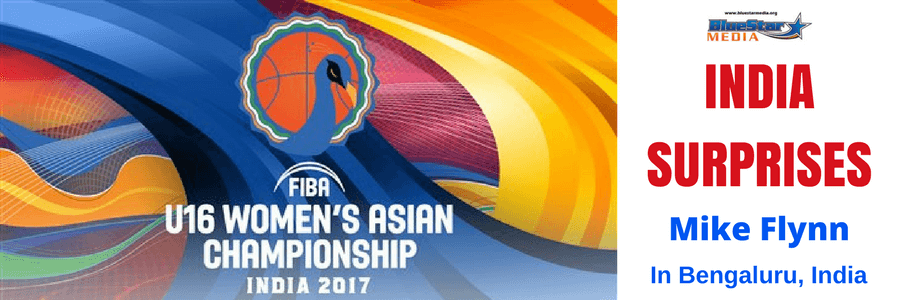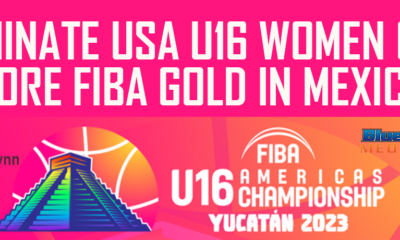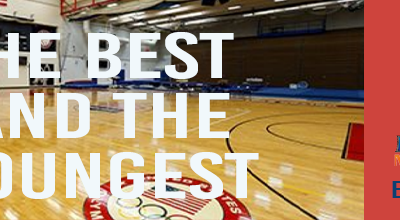BENGALURU – It was with much trepidation that I decided to make plans to come to this large and adventurous country to watch the FIBA Asia U16 Women’s Championships. My only prior experiences with India were either through movies, tv shows or your typical restaurants mostly in London. And, after a week here enjoying the atmosphere and basketball – I am glad I came.
First off this is on the other side of the world. Getting here for me was a trip to Hong Kong and then Singapore which might be the most beautiful city in the world. After a few days it was time for the 4hr flight to Bengaluru (Bangalore) which sits in the middle south central part of the vast and populous country which is known for its high tech. A big Apple conference is going on here right now.
The adventure was FIBA placing not one but two Women’s Championships here. The FIBA Women’s Asia Women’s Cup was held in late July to be followed by the Women’s 16 Championships. Both utilized the very spacious Sree-Kanteerava Indoor Stadium. The space was so big you could have marked off four full wood floor courts side-by-side going sideways. Nice for development, rough for viewing anyplace by at mid-court.
When the idea of coming to India for the Asia U16 was being bantered there was no information on what city would be the host. After the Women’s Cup the facility was deep in water after local flooding filled the arena. When the authorities deal with the water and floor problem this event was back here instead of going elsewhere in India.
I wanted to attend to view in person the great Australian juggernaut which has won the last U17 World Championship beating the USA in Zaragoza, Spain in 2016. And, this would be the first time that a combined FIBA Zones of Oceania (Australia / New Zealand) would compete in the same event with Asia teams (China, Japan, Korea). This combined zone accounts for four places at the 2018 U17 World Cup.
FIBA does everyone women’s basketball fan a global service by live streaming each game via their YouTube site and coupled with their fabulous Live Stats pages is unsurpassed for viewer enjoyment. This feat alone has been a hallmark of FIBA’s global basketball development plan.
I got here on the off day between Group Phase play and Bracket Play. I had a change to get into my hotel (a Marriott brand of course) and decided to catch up on emails and look though the various rosters for each country’s top performers and young talent.
There were two Division of teams here: A with Australia, Japan, New Zealand, Korea, Chinese Taipei, Thailand, and Hong Kong. Division B with India, Malaysia, Kazakhstan, Sri Lanka, Iran, Nepal and Maldives playing in another Arena close by.
Through the first five games of competition neither finalists Australia nor Japan had a close game from expected competition in China and New Zealand respectively that eventually squared off for the bronze won by the Chinese 60-43.
It was nice to come and see the talent of Thailand, the hustle of a small Chinese Taipei, a very young Korea squad and finally a surprisingly good host team India in Division B.
India impressed with winning the Division B over Malaysia 64-48 to win advancement to Division A next year. For Division B there are no medals, just advancement but for these talented Indian girls it was a gold medal tournament performance.
There are at least 2-3 girls with lower to mid-level NCAA Division 1 talent and two very young post players with a future. This team was better than the bottom two in Division A. Basketball is not considered a big sport here with cricket and soccer being the norms. FIBA, the NBA and assorted basketball trainers have worked this second-most populous country for a decade to grow the game. For the women’s side, it’s working.
The Division A championship game did not disappoint. After watching them both compete twice up-front and in person both teams had enough talent and style of play to beat the other. In fact, after watching the FIBA U16 Americas and U16 Europeans both of these teams would give their respective winners the USA and France a game.
To appreciate this typically small Japan team all you have to do is watch their warmup drills – precision. They are known fast pace, in-your-face man defense and relentless 3-point shooting. The defending FIBA U17 world champion Aussie juggernaut is such because they select females with relentless push and also precision with their sets, defense schemes and hard play – all traits to make the FIBA U16 championships as memorable as the 61-60 victory made it.
There’s no use telling you about the game unless you go online and watch it if you didn’t watch it live. The points of interest was that Japan jumped out to a double-digit lead in the first quarter with efforts from Maya McArthur, Miku Takahaski and Maika Miura. Australia closed it up by halftime 51-48 and made the adjustment to go with a smaller guard lineup to counter the Japanese. The final five minutes were situations where both teams had numerous chances to win with the Aussies making defensive stops and Japan missing shots. It was an enjoyable final game where the takeaway was that the rest of the FIBA U17 teams headed to Minsk, Belarus next July better beware including the other Zone winners.
ALL-STARS: There was no All-Star team selected here but as I did with the FIBA U16s in France, here’s the list of players that would’ve made my team.
MVP – 5 Georgia Amoore 5-6 PG Australia
7 Isabel Palamer 5-10 W Australia
9 Nnenna Emma-Nnopu 6-0 F Australia
14 Akira Hirashita 5-9 W Japan
3 Sharne Pupuke-Robarti 5-11 F New Zealand
Surprisingly my MVP Aussie point guard Georgia Amoore does not start for the gold medal winners but she is on the floor and makes things happen. Australia has at least three players that come in and give them even more firepower in Amoore, 5-10 Last-Tear Poa and 6-0 Alexandria Fowler. This is why they are hard to play and beat as there is no letup in pace and style. This depth and versatility is what helped them comeback and beat Japan.
MINSK U17: It goes without saying after watching three U16 FIBA Championships in person the edge in physical talent would go to the USA and France – both so scary athletic that precision team basketball played by Australia, Spain, Japan and even Hungary could make them upset targets. Sure Australia is the favored going into Minsk as the defending champ based on they just play harder than both the USA and France.
USAU17: Every aspiring U17 candidate looking to snare a spot on the 2018 USA U17 team regardless if they made the roster or to the final cuts needs to watch and absorb the pace and style of the Aussies and Japan. Having a physically imposing lineup like France and the USA has lead to moments of sloppy play and lack of focus which these Asia finalist will take advantage of. No high-level American travel team keeps this pace and their stars are not required to push this hard either. Summer ball domination comes in spurts. FIBA is relentless pace and push.
RECRUITING: Obviously any American College Coach would love to recruit any of the top eight Australian player, probably the entire roster. For some its hard to distinguish the difference between how hard they play internationally and the adjustment to the USA college game. This Aussie team has no bonafide pros but some very good pieces and possible impact players. No one recruits Japan openly as they usually stay home in their own pro league. China is the same with their pro teams developing younger talent eventually into their squad. There’s small better guard talent in the US than to look overseas. It’s rare that an American School player in Asia can dominate enough to get a major D1 ride. For this reason, few American College Coaches venture outside of Australia or New Zealand and if they do, they are usually West Coast colleges.
INDIA: Ok – they didn’t get the gold medal but they cheered like it happened. This was a big statement for these girls. There are few places in India for girls to play. If you’re playing it’s outdoors. I loved the smoothness of their moves, not stiff like the some of the Chinese. If this is the first wave of talent, the future is bright. It make take another decade before the shear India population size produces talent on a scale of the other major powers. The interesting battle will be who can advance their game quicker for women – China or India. My bet is India closes the gap real fast in next decade.
THANKS: A shout-out to FIBA Asia Media chief Hovsep Seraydarian who provided me with insights on the event coming to Bangalore and the work done by Basketball Federation India (BFI) to support women’s basketball. Can’t forget the input from long-time FIBA event specialist Nelson Isley who I missed here at this event.
Mike Flynn is owner and operator of Blue Star Basketball and U.S. Junior Nationals. He is a National Evaluator and publishes the Blue Star Report which ranks the top 100 high school girls basketball players in the nation. He also serves as Secretary of the Middle Atlantic District AAU, National Chair for AAU Lacrosse, Consultant to Gatorade for girls basketball, member of the McDonald's All–American selection committee, & Consultant for Nike Global Basketball.











